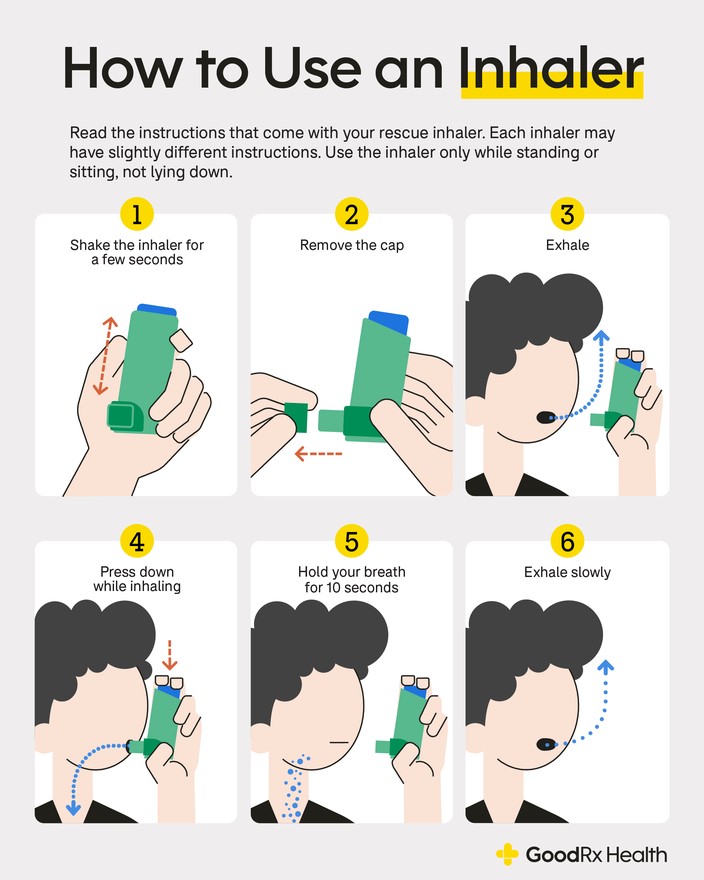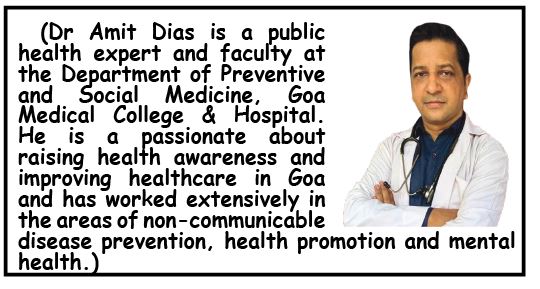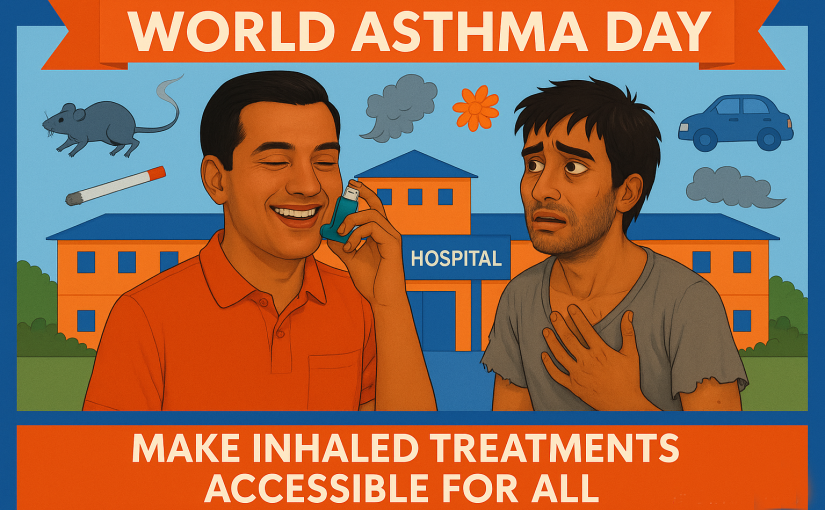Q&A interview with Dr Amit Dias on World Asthma Day
World Asthma Day is observed on the first Tuesday of May each year, this year it falls on May 6. This year’s theme is “Making Inhaled Treatments Accessible to All.” Dr Amit Dias, faculty at the Department of Preventive & Social Medicine, Goa Medical College & Hospital, tells us more about the basics of asthma care. He says, “Asthma can make breathing feel like a workout and affect your mental health and quality of life. The real challenge is ensuring that every patient has access to the inhalers and treatment they need.”
Goan Observer: Doctor, what is the global and national scenario when it comes to asthma, and what is the focus of this awareness drive this year?
Dr Amit Dias: Asthma is a major non-communicable disease affecting people of all ages. During an asthma attack, the feeling is akin to a fish out of water. You’re gasping, struggling to take in enough air. This not only disrupts their physical health, but also causes a lot of anxiety and affects mental wellbeing. Timely and proper treatment of asthma is absolutely essential. The patients need counselling.
Globally, it is estimated that over 339 million people are living with asthma, and unfortunately, it caused around 4,55,000 deaths in 2019, according to WHO. In India alone, over 37.9 million people are estimated to have asthma — that’s nearly 11% of the global burden, despite India making up just over 17% of the world’s population.
This year’s theme, “Making Inhaled Treatments Accessible to All,” emphasizes not just the medical side of treatment, but the urgent need to remove systemic barriers so people get the medication they need — particularly inhaled corticosteroids, which can literally save lives.
Q: What exactly is asthma, and why is it such a challenge to manage?
A: Asthma is a chronic inflammatory disease of the airways. Imagine the airways as tubes that carry air in and out of your lungs. In asthma, these tubes become inflamed, the muscles around them tighten, and they produce extra mucus, making it difficult to breathe.
Symptoms include wheezing, coughing, chest tightness, and shortness of breath — often worse at night or early in the morning. While the symptoms may seem to come and go, asthma is always lurking in the background unless it’s well-managed.
The tragedy is that many of these deaths are preventable. Most of them occur in low- and middle-income countries, where access to timely diagnosis and inhaled treatments is limited. In Goa we are fortunate that these inhalers are provided free of cost through the health care system.
Q: You mentioned about inhalers — what exactly are these? Why are they considered better than the ones given orally?
A: Great question. Inhaled treatments are medications delivered directly to the lungs using devices such as inhalers, spacers, or nebulizers. There are two main categories:
Reliever inhalers – such as short-acting bronchodilators, used during an asthma attack to rapidly open the airways.
Controller inhalers – usually inhaled corticosteroids (ICS) or combination inhalers, taken daily to reduce inflammation and prevent attacks.
Inhaled medications are preferred because they:
Act faster, providing quicker relief.
Require lower doses than oral medications.
Have fewer systemic side effects.
Target the lungs directly — where the problem is.
Unfortunately, access to these life-saving medications remains a challenge. In many parts of India and the world, people rely on outdated oral treatments, which are less effective and have more side effects. It can also lead to a lot of mental health issues.
Q: How does asthma affect mental health?
A: Asthma can make breathing feel like a workout and affect your mental health and quality of life. Though it is primarily a physical condition, it can have a significant impact on mental health — and it’s something that is often overlooked. Living with a chronic condition like asthma can lead to anxiety, depression and stress, especially when symptoms are unpredictable or severe. Imagine having an asthma attack — your chest is tight, you’re gasping for breath — it’s not just physically distressing, but also psychologically terrifying, sometimes even traumatic.
Q: What exactly causes this anxiety?
A: There can be various causes for this:
Fear of an attack: People with asthma may constantly worry about when the next episode will strike. This can create a persistent state of anxiety.
Sleep disturbances: Asthma often worsens at night, affecting sleep, which in turn increases irritability, fatigue, and anxiety.
Limitations in activity: Children may avoid sports, adults may fear exertion. This can lead to feelings of isolation and low self-esteem.
Stigma and misunderstanding: Social stigma, especially in schools or workplaces, can cause embarrassment or reluctance to use inhalers in public.
Remember, anxiety can, in fact, worsen asthma — it triggers hyperventilation and makes the person feel breathless even if their lungs are functioning relatively well. This overlap of symptoms between anxiety and asthma can create a vicious cycle.
Q: How to we deal with anxiety in people with asthma?
A: Here are 7 strategies to deal with it:
- Education is empowerment
Understanding asthma — its triggers, treatment, and management — can greatly reduce fear. Once people realize it’s a controllable condition, their confidence improves. - Create a personalized Asthma Action Plan
Having a clear step-by-step plan for managing symptoms and knowing when to seek help provides a sense of control, which reduces anxiety. - Mind-body techniques
Practices like deep breathing exercises, mindfulness meditation, yoga, and progressive muscle relaxation can help calm the mind and improve breathing. - Cognitive Behavioral Therapy (CBT)
CBT is a proven therapy that can help people recognize and reframe negative thoughts around their illness and reduce anxiety levels. - Address sleep issues
Managing night-time asthma and improving sleep hygiene will help restore mental well-being. - Support groups
Talking to others with asthma can reduce the feeling of isolation. Peer support groups (even online ones) can be therapeutic. - Involve a mental health professional when needed
If anxiety is affecting quality of life, it’s important to consult a psychologist or psychiatrist. A holistic approach is always better.
Q: You mentioned about inhalers, many people find it difficult to use them. What is the correct method to use inhalers ?
A: The difficulty is only in the beginning. Once they learn the technique, it becomes easy. Let me share this info-graphic that explain the steps in using an inhaler.
Q: If someone has only mild symptoms, can they stop using their inhaler and just live with the condition?
A: That’s a common misconception — and a dangerous one. Asthma can be deceptive. Even when symptoms are mild or seem to go away, the underlying inflammation may still be active. Discontinuing treatment can lead to severe flare-ups, sometimes even life-threatening ones.
Think of asthma as a smoldering fire — it might look calm, but if you don’t treat it, it can flare up unpredictably. Stopping inhaled corticosteroids without medical advice is risky. Always consult your doctor before making any changes.

Q: What are the complications of untreated or poorly managed asthma?
A: When asthma is not adequately treated, the consequences can be serious:
Frequent hospitalizations and emergency visits.
Permanent narrowing of the airways — a condition known as airway remodeling.
Decreased lung function over time.
Poor quality of life — missed school, work, and social activities.
And in severe cases, death from an acute asthma attack.
Moreover, poorly managed asthma in children can affect their growth, education and development. It’s not just a health issue; it’s a social and economic burden.
Q: What are the common asthma triggers, and how can they be managed?
A: Triggers can vary from person to person, but common ones include:
Allergens: pollen, dust mites, pet dander, molds
Air pollution: smoke, car exhaust, industrial fumes
Weather changes, especially cold air
Exercise-induced asthma
Stress and strong emotions
Certain foods, fragrances, or medications
The first step in asthma care is identifying and avoiding your triggers. A good asthma action plan includes these preventive strategies along with appropriate medications.
Q: What’s your final message for our readers on World Asthma Day?
A: Let’s stop normalizing breathlessness. Asthma is treatable, and most people with asthma can lead active, healthy lives with the right care. But for that to happen, we need to:
Raise awareness about asthma and its symptoms
Promote early diagnosis and regular follow-up
Ensure access to affordable and quality inhaled medication
Empower patients to understand and manage their condition
Let’s use this World Asthma Day to advocate for inhalers in every home that needs one, and not just on a prescription slip in a forgotten file. Let’s breathe freely — and equally.

